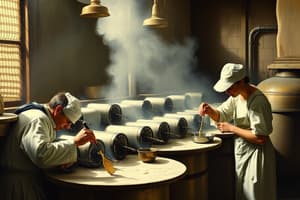Podcast
Questions and Answers
What is the unit of measurement for the standard chemical exergy in Table 2?
What is the unit of measurement for the standard chemical exergy in Table 2?
- J/mol
- kJ/kg
- kJ/g
- kJ/mol (correct)
Which component has the highest specific chemical exergy in Table 2?
Which component has the highest specific chemical exergy in Table 2?
- Immunoglobulin M (correct)
- Palmitic acid
- Lactose
- αs1-casein
What is the purpose of the Bactocatch-assisted pasteurization line in the UF cheese production plant?
What is the purpose of the Bactocatch-assisted pasteurization line in the UF cheese production plant?
- To allocate the exergy destruction of the system (correct)
- To determine the chemical exergy of milk components
- To homogenize the milk
- To produce cheese with a specific fat content
What is the total specific chemical exergy of the 3.60% fat whole milk in Table 2?
What is the total specific chemical exergy of the 3.60% fat whole milk in Table 2?
Which of the following is NOT a component of milk in Table 2?
Which of the following is NOT a component of milk in Table 2?
What is the primary purpose of the homogenization process in milk production?
What is the primary purpose of the homogenization process in milk production?
Which component has a specific chemical exergy of 9.50E-01 kJ/mol in Table 2?
Which component has a specific chemical exergy of 9.50E-01 kJ/mol in Table 2?
What is the unit of measurement for the specific chemical exergy in Table 2?
What is the unit of measurement for the specific chemical exergy in Table 2?
Which of the following components has the lowest specific chemical exergy in Table 2?
Which of the following components has the lowest specific chemical exergy in Table 2?
What is the purpose of determining the exergy destruction rate of each subcomponent in the UF cheese production plant?
What is the purpose of determining the exergy destruction rate of each subcomponent in the UF cheese production plant?
Flashcards are hidden until you start studying
Study Notes
Milk Processing Plant
- The plant consists of several components, including:
- Central plate heat exchanger (G)
- Two plate heat exchangers (B and S)
- Silo tank (C)
- Intermediate storage tank (Q) with agitator
- Balance tank (E) with agitator
- Deaerator (H)
- Fat separator (K)
- Automatic fat standardization device (L)
- Bactocatch (N)
- Holding tube (P)
- Vacuum pump (T)
- Eight pumps (A, D, F, I, J, M, O, and R)
Compositions of Milk and Its Derivatives
- The compositions of milk and its derivatives are given in Table 1.
- The components include:
- Water
- Fat
- Carbohydrate
- Protein
- Ash
Specific Heat Capacities and Specific Volumes
- The specific heat capacities and specific volumes of milk components can be considered as a function of the processing temperature.
- Mathematical equations used in the calculation of specific heat capacities and densities of milk constituents were adopted from Singh and Heldman.
Chemical Exergy Rates
- The chemical exergy rates of milk and its derivatives were estimated using Eq. 8 with respect to their chemical compositions at different points of the plant.
- The standard chemical exergies of milk inorganic ingredients were gathered from the published report.
- A semi-theoretical model developed by Song et al. was applied to compute the standard chemical exergies of milk organic components.
Exergy Destruction and Improvement Potential
- The exergy destruction and improvement potential rates were determined for each subcomponent of the system.
- The results showed that the maximum exergy destruction occurred in the boiler and compressor combination, followed by the pressure pump.
Fat Droplets and Interfacial Tension
- The size of fat droplets is about 3.6 µm in the freshly harvested cattle milk.
- The size of fat droplets reaches 1 µm after the homogenization process.
- The interfacial tension between the fat droplets and milk plasma is about 1-2 mN/m in the raw cattle milk.
- The interfacial tension increases to about 15 mN/m immediately after homogenization and then decreases to about 3-4 mN/m shortly after homogenization.
Studying That Suits You
Use AI to generate personalized quizzes and flashcards to suit your learning preferences.




